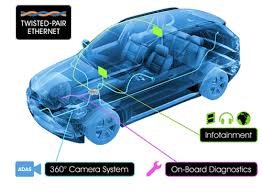
As in-car Ethernet networks start looking more and more like data centers, a growing number of the world’s leading car makers are adopting one-pair automotive Ethernet technology as their connectivity solution of choice. Vehicles connected through this system include the BMW X3, X4, X5, X6, i3, i8, 6 Series and 7 Series vehicles; the Jaguar XJ and XF and the Volkswagen Passat.
In-car networks are increasingly being designed-in, and deployed to connect systems such as infotainment, driver assist, and safety. Often on shared high-bandwidth infrastructures. It estimated that by 2020 there will be over 1,000 semiconductor chips in the average car. In response to the challenge, leading players in the industry have established the OPEN Alliance (One-Pair EtherNet) Special Interest Group (SIG), a non-profit industry alliance established to drive wide scale adoption of Ethernet-based automotive connectivity.
“Since the formation of the OPEN Alliance, interest in one pair automotive Ethernet technology has risen at a dramatic pace. Today, membership in the SIG stands at nearly 300 auto and tech companies, representing a 36X increase in just four years,” says Natalie A. Wienckowski, Strategy Lead, Core Hardware Team at General Motors and Chair for the OPEN Alliance SIG.
“There is no doubt that consumer demand for advanced driver assistance and infotainment features are on the rise,” says Dr Kirsten Matheus, Ethernet Project Manager at BMW. “One pair automotive Ethernet technology provides a single, centralized network backbone that simplifies the deployment of advanced features.” “In the past, automakers relied on a variety of connectivity solutions in each of the isolated domains inside the vehicle,” adds Dr. Ali Abaye, Senior Director of Automotive at Broadcom. “BroadR-Reach automotive Ethernet technology enables automakers to introduce luxury-model safety and infotainment features throughout the fleet, including mid-range and economy class vehicles.”
The OPEN Alliance demonstrated the industry’s first multi-vendor interoperability demonstration of single-pair automotive Ethernet technology in October 2015 at the IEEE Ethernet & IP @ Automotive Tech Day held in Yokohama, Japan. The demonstration, coordinated by the C&S Group, showed Broadcom, NXP and Realtek 100BASE-T1 physical layer transceivers (PHYs) working together in a single platform and communicating over OPEN Alliance compliant cable assemblies made by Delphi, Molex, TE Connectivity and Yazaki.
Automotive Industries (AI) asked Natalie A. Wienckowski, General Motors’ Architect – Electronics Hardware Global Lead and OPEN Alliance SIG, what are the advantages of the next generation IEEE 1000BASE-T1 technology, which is expected to be released in early 2016.
Wienckowski: 1000BASE-T1 keeps the single pair, full duplex operation of 100BASE-T1 while increasing the bandwidth 10-fold. This additional bandwidth will be required to connect 100BASE-T1 links together across a backbone. This increased bandwidth will also be required for today’s higher resolution cameras and displays.
AI: What is being done to protect connected cars from hacking?
Wienckowski: For decades, Ethernet has served as the world’s most popular and reliable networking technology, with a history of successful and secure deployment in dynamic environments like the enterprise. Now, the inherent security features of Ethernet and availability of a number of other techniques and standards to further bolster its security, have automakers eying it at as well.
Ethernet uses a standard packet format, which includes a source and destination address, which provides a basic level of authentication, isolation and data integrity. Because in-car networks are known and predictable, their operation can be tightly configured and constrained.
Packet addresses can be used by Ethernet switches to provide traffic isolation and filtering, through either static provisioning or dynamic learning.
In other words, Ethernet technology can isolate different traffic types on a shared physical network so that devices are only allowed to talk to other devices within their domain, essentially separating the infotainment system from mission-critical applications, such as the braking system, steering and engine control unit. Fully optimized for in-vehicle applications, Automotive Ethernet transforms the entire vehicle into a centralized, secure data center – on wheels – with proven standards of compliance, performance and protection.
AI: Is Ethernet the most cost-effective solution for in-car connectivity?
Wienckowski: Cost is dependent on a number of factors that vary by application and implementation. AI: What are the major challenges facing the OPEN Alliance in the rollout of automotive Ethernet technology?
Wienckowski: Until recently, the challenge of OPEN was to have multiple suppliers of 100BASE-T1 PHYs. In October 2015 at Ethernet IP Tech Day, OPEN demonstrated a network of interoperable PHYs from three vendors including Broadcom, NXP and Realtek, operating over cables from four vendors (Delphi, Molex, TE Connectivity and Yazaki). The demonstration, coordinated by the C&S Group, showed PHY and switch products interconnected using a variety of cables and inline-connectors in a switched architecture, simultaneously transferring HD video stream over the network. Our next challenge is to provide the support documents required to do the same with 1000BASE-T1.
AI: How are you overcoming those challenges?
Wienckowski: Through the cooperation of nearly 300 OPEN Members; including OEMs, Tier 1s, semiconductor vendors, cable suppliers, connector suppliers, harness suppliers, tool suppliers, universities and many others; and their wide range of experiences in the communications world, we are able to anticipate potential holes and fill them before they become issues. However, if an issue is discovered, we are able to find members who are able to help solve this for the community











More Stories
New updated edition of “PXIMate” reference guide for T&M engineers available from Pickering Interfaces
5 Mistakes That Can Ruin Your Car Accident Claim
Auto Repair Services: Keeping Your Vehicle Road-Ready